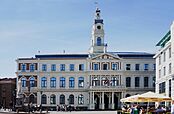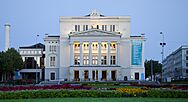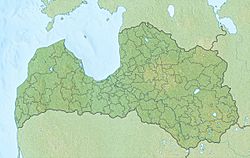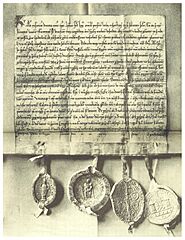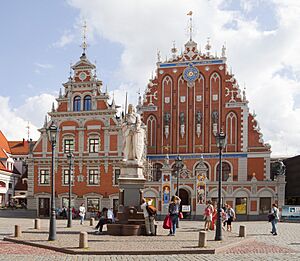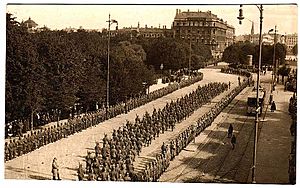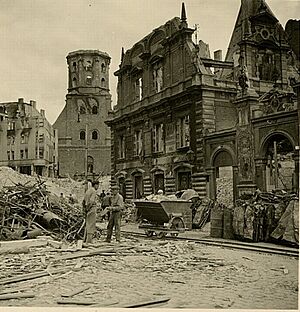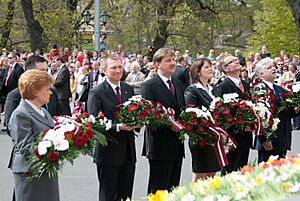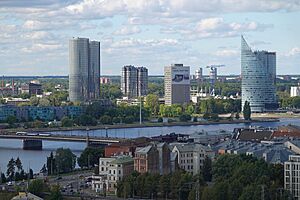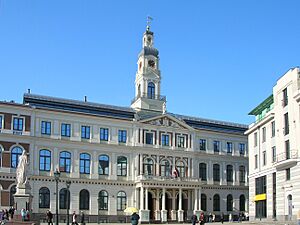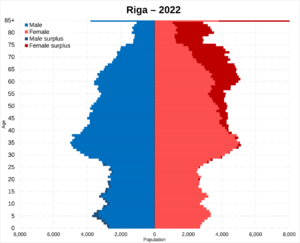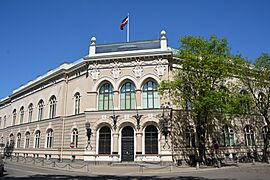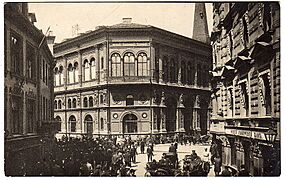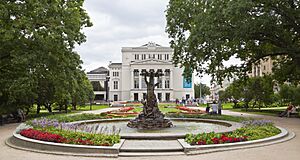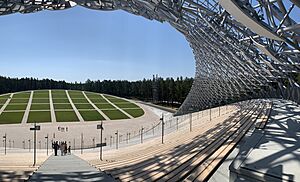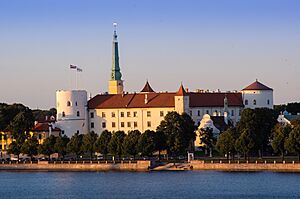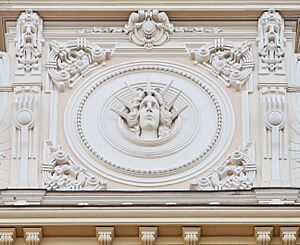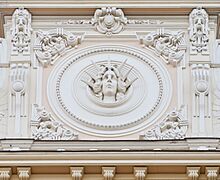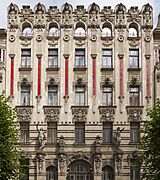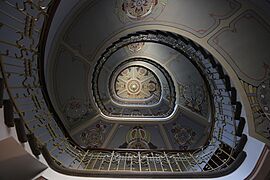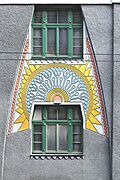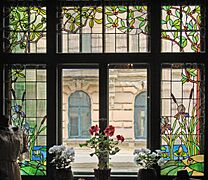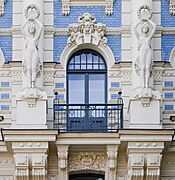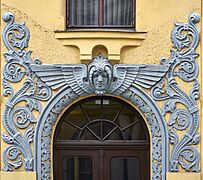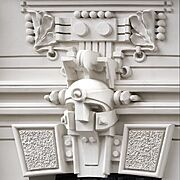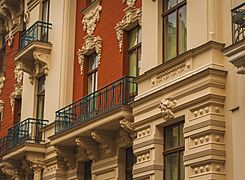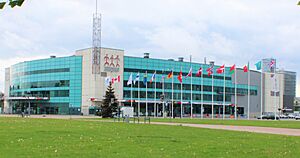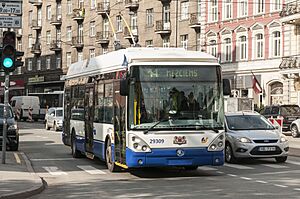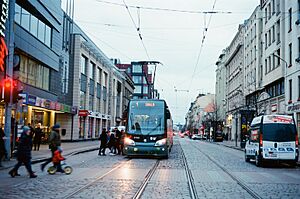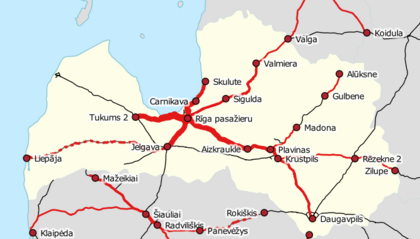Riga facts for kids
Quick facts for kids
Riga
|
|||||
|---|---|---|---|---|---|
|
Capital city and state city
|
|||||
|
Skyline of Riga from Daugava
Riga City Hall
Riga Cathedral
House of the Blackheads
Latvian National Opera
National Library of Latvia
Albert Street 8
|
|||||
|
|||||
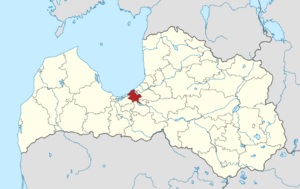
Riga highlighted in red inside of Latvia
|
|||||
| Country | Latvia | ||||
| Government | |||||
| • Type | City Council | ||||
| Area | |||||
| • Capital city and state city | Lua error in Module:Wd at line 1,575: attempt to index field 'wikibase' (a nil value). km2 (Formatting error: invalid input when rounding sq mi) | ||||
| • Land | Lua error in Module:Wd at line 1,575: attempt to index field 'wikibase' (a nil value). km2 (Formatting error: invalid input when rounding sq mi) | ||||
| • Water | Expression error: Unexpected < operator. km2 (Formatting error: invalid input when rounding sq mi) 15.8% | ||||
| • Metro | 3,359 km2 (1,297 sq mi) | ||||
| Population
(2025)
|
|||||
| • Capital city and state city | 591,882 | ||||
| • Urban | 927,953 | ||||
| • Metro | 847,162 | ||||
| • Metro density | 252.21/km2 (653.21/sq mi) | ||||
| • Demonym | Rigan (Rīdzinieks) | ||||
| GDP | |||||
| • Capital city and state city | 19,261,334,000 Euro (2022) | ||||
| • Per capita | 31,583 Euro (2022) | ||||
| Time zone | UTC+2 (EET) | ||||
| • Summer (DST) | UTC+3 (EEST) | ||||
| Calling codes | 66 and 67 | ||||
| City budget | €1.7 billion (2025) | ||||
| HDI (2022) | 0.937 – very high | ||||
| Official name: Historic Centre of Riga | |||||
| Type: | Cultural | ||||
| Criteria: | ii, i | ||||
| Designated: | 1997 | ||||
| UNESCO region: | Europe | ||||
Riga is the capital and largest city of Latvia. It is home to about 591,882 people, which is about one-third of Latvia's total population. The city is located on the Gulf of Riga, where the Daugava River meets the Baltic Sea. Riga covers an area of 307.17 square kilometers and is mostly flat.
Riga was founded in 1201 and was once a member of the Hanseatic League, a powerful trading group. Its historic center is a UNESCO World Heritage Site, famous for its unique Art Nouveau buildings and 19th-century wooden houses. Riga was the European Capital of Culture in 2014. It has also hosted major international events like the Eurovision Song Contest 2003 and several Ice Hockey World Championships.
In 2019, Riga welcomed over 1.4 million international visitors. The city is served by Riga International Airport, the busiest airport in the Baltic states. Riga is also part of several important European city networks.
Contents
What's in a Name?
The exact origin of the name Riga is not fully known, but there are a few ideas:
- Some think it comes from Riege, the German name for the Rīdzene River, which used to flow into the Daugava.
- Another idea is that it comes from the Latin word rigata, meaning "irrigated." This was used by Bishop Albert to describe bringing Christianity to the local people.
The most accepted idea comes from a German historian, Dionysius Fabricius (1610). He said Riga got its name from the many warehouses along the Daugava River. The local Liv people called these warehouses Riae. The "j" sound in the Latvian word rīja (warehouse) changed to a "g" sound in German.
A Look Back at Riga's Past
How Riga Began
The Daugava River has been an important trade route for a very long time. It was part of a path used by Vikings to travel to Byzantium. A safe natural harbor, where Riga is today, was noted as early as the 2nd century. The Livs, a local tribe, lived there.
Riga started to grow as a trading center during the Viking Age. People living there mainly fished, raised animals, and traded. They also developed skills in crafts like working with bone, wood, amber, and iron.
German traders began visiting Riga in 1158. A monk named Meinhard of Segeberg arrived to convert the Livs to Christianity. He built a castle and church upstream from Riga. However, the Livs continued their traditional beliefs.
In 1198, Bishop Berthold arrived with crusaders to force Christianization. After his forces were defeated, Pope Innocent III called for a crusade. Bishop Albert arrived in Riga in 1200 with 23 ships. In 1201, he moved the main church center to Riga.
Bishop Albert's Influence
In 1202, Albert created the Livonian Brothers of the Sword to protect the new territory and trade. He began to fortify the town in 1207. Albert made sure Riga would be a successful trading city. He got special permission from the Pope that all German merchants had to trade through Riga.
In 1211, Riga started making its own money. Albert also began building the Riga Dom. Riga's citizens wanted more control over their city. In 1221, they gained the right to manage Riga themselves and created their own city rules.
Albert faced challenges from the citizens. In 1225, a deal was made: citizens no longer had to pay taxes to the Bishop. They also gained the right to choose their own leaders. Albert died in 1229. He helped establish German influence over Livonia for many centuries.
Riga and the Hanseatic League
In 1282, Riga joined the Hanseatic League. This was a powerful group of trading cities in Northern Europe. Being a member helped Riga become economically strong and stable. This stability helped the city through many conflicts over the years.
Changes in Power: Empires and Wars
As the Hanseatic League became less powerful, other countries wanted to control Riga. Riga accepted the Reformation in 1522, which ended the power of the archbishops. After the Livonian War ended in 1581, Riga became a free imperial city for a short time. Then, it came under the control of Poland–Lithuania.
In 1621, during a war between Poland and Sweden, Riga was taken by Gustavus Adolphus, the King of Sweden. Riga remained one of the largest cities under Swedish rule until 1710. During this time, the city kept a lot of its own self-government.
In 1710, during the Great Northern War, Russian forces under Peter the Great captured Riga. Riga became part of the Russian Empire. Even with these changes, the Baltic Germans living in Riga kept a strong position. By 1867, nearly half of Riga's population was German.
In the late 1800s, more Latvians moved to Riga. The city became a center for the Latvian National Awakening. This was a movement where Latvians started to celebrate their own culture and language.
World War I and Independence
World War I and the Russian Revolution of 1917 greatly affected Riga. German troops entered Riga in September 1917. After the war ended, Latvia, with Riga as its capital, declared its independence on November 18, 1918. Between World War I and World War II, Riga and Latvia focused on trade with Western European countries.
World War II and Soviet Times
During World War II, Latvia was occupied by the Soviet Union in 1940. Then, Nazi Germany occupied it from 1941 to 1944. When the Soviets took control, many people were arrested and deported. The June deportation in 1941 saw thousands of Latvians, including government leaders, sent away. The former KGB headquarters in Riga is now a museum.
During the Nazi occupation, the Jewish community was forced into the Riga Ghetto. Many Latvian Jews were killed in massacres in 1941. By the end of the war, most remaining Baltic Germans were moved to Germany.

The Soviet Red Army took Riga back on October 13, 1944. After the war, many people from Russia and other Soviet areas moved to Riga. Large apartment buildings were built for these new residents.
Riga's historic center was heavily damaged during the war. After the war, many famous buildings were rebuilt. For example, St. Peter's Church lost its wooden tower but was rebuilt. The House of the Blackheads was completely destroyed and later rebuilt in 1995. By 1989, the percentage of Latvians in Riga had dropped to 36.5%.
Riga in the 21st Century
In 2004, cheaper flights brought many more tourists to Riga. In 2013, a supermarket roof collapsed in Riga, killing 54 people.
Riga was the European Capital of Culture in 2014. In 2022, after the 2022 Russian invasion of Ukraine, the city council voted to remove the Monument to the Liberators of Soviet Latvia and Riga from the German Fascist Invaders. The monument was demolished in August 2022. The street where the Russian Embassy is located was renamed "Independent Ukraine Street."
Today, Riga is seeing more construction projects that use underground spaces. This allows for new archaeological discoveries but also means some historical sites are not preserved in their original location.
Riga's Location and Layout
Riga is one of the largest cities in the Baltic states (Latvia, Lithuania, and Estonia). About one-tenth of the total population of these three countries lives in Riga.
City Districts
Riga is divided into six main administrative areas:
- Central District (3 km2)
- Kurzeme District (79 km2)
- Zemgale Suburb (41 km2)
- Northern District (77 km2)
- Vidzeme Suburb (57 km2)
- Latgale Suburb (50 km2)
These divisions were set up in 1941 and 1969. The Riga City Council is also working on a plan to officially divide Riga into 58 smaller neighborhoods.
Weather in Riga
Riga has a humid continental climate. This means it has warm summers and cold winters. January and February are the coldest months, with average temperatures around -2.1°C. Temperatures can drop to -20°C or -25°C almost every winter.
The sea nearby causes frequent rain and fog in autumn. Snow can cover the ground for about eighty days. Summers are mild and rainy, with an average temperature of 18°C. On the hottest days, temperatures can go above 30°C.
| Climate data for Riga (1991–2020 normals, extremes 1885–present) | |||||||||||||
|---|---|---|---|---|---|---|---|---|---|---|---|---|---|
| Month | Jan | Feb | Mar | Apr | May | Jun | Jul | Aug | Sep | Oct | Nov | Dec | Year |
| Record high °C (°F) | 10.2 (50.4) |
13.6 (56.5) |
21.7 (71.1) |
28.0 (82.4) |
30.5 (86.9) |
34.0 (93.2) |
34.5 (94.1) |
33.9 (93.0) |
29.4 (84.9) |
23.4 (74.1) |
17.2 (63.0) |
11.8 (53.2) |
34.5 (94.1) |
| Mean maximum °C (°F) | 5.9 (42.6) |
6.1 (43.0) |
12.7 (54.9) |
21.5 (70.7) |
26.3 (79.3) |
28.4 (83.1) |
30.1 (86.2) |
29.4 (84.9) |
23.9 (75.0) |
17.3 (63.1) |
10.9 (51.6) |
6.7 (44.1) |
31.4 (88.5) |
| Mean daily maximum °C (°F) | −0.1 (31.8) |
0.3 (32.5) |
4.8 (40.6) |
11.9 (53.4) |
17.8 (64.0) |
21.3 (70.3) |
23.8 (74.8) |
22.7 (72.9) |
17.3 (63.1) |
10.5 (50.9) |
4.8 (40.6) |
1.4 (34.5) |
11.4 (52.5) |
| Daily mean °C (°F) | −2.1 (28.2) |
−2.0 (28.4) |
1.5 (34.7) |
7.4 (45.3) |
13.0 (55.4) |
16.7 (62.1) |
19.3 (66.7) |
18.3 (64.9) |
13.4 (56.1) |
7.5 (45.5) |
3.0 (37.4) |
−0.3 (31.5) |
8.0 (46.4) |
| Mean daily minimum °C (°F) | −4.5 (23.9) |
−4.6 (23.7) |
−1.7 (28.9) |
2.9 (37.2) |
8.2 (46.8) |
12.4 (54.3) |
14.9 (58.8) |
14.1 (57.4) |
9.8 (49.6) |
4.9 (40.8) |
1.1 (34.0) |
−2.4 (27.7) |
4.6 (40.3) |
| Mean minimum °C (°F) | −16.4 (2.5) |
−15.8 (3.6) |
−10.4 (13.3) |
−3.9 (25.0) |
0.2 (32.4) |
5.3 (41.5) |
9.3 (48.7) |
8.0 (46.4) |
3.0 (37.4) |
−2.4 (27.7) |
−6.5 (20.3) |
−11.4 (11.5) |
−20.3 (−4.5) |
| Record low °C (°F) | −33.7 (−28.7) |
−34.9 (−30.8) |
−30.3 (−22.5) |
−13.1 (8.4) |
−5.5 (22.1) |
−2.3 (27.9) |
4.0 (39.2) |
0.0 (32.0) |
−4.1 (24.6) |
−9.5 (14.9) |
−20.5 (−4.9) |
−31.9 (−25.4) |
−34.9 (−30.8) |
| Average precipitation mm (inches) | 46.5 (1.83) |
40.1 (1.58) |
34.1 (1.34) |
35.0 (1.38) |
47.5 (1.87) |
65.0 (2.56) |
79.5 (3.13) |
77.9 (3.07) |
67.1 (2.64) |
75.6 (2.98) |
56.3 (2.22) |
50.2 (1.98) |
674.8 (26.58) |
| Average snowfall cm (inches) | 25.0 (9.8) |
23.6 (9.3) |
15.7 (6.2) |
5.2 (2.0) |
0.0 (0.0) |
0.0 (0.0) |
0.0 (0.0) |
0.0 (0.0) |
0.0 (0.0) |
1.2 (0.5) |
7.0 (2.8) |
22.0 (8.7) |
99.7 (39.3) |
| Average precipitation days (≥ 1.0mm) | 11 | 9 | 8 | 7 | 8 | 10 | 9 | 10 | 9 | 12 | 11 | 11 | 115 |
| Average relative humidity (%) | 85.9 | 82.4 | 76.0 | 68.2 | 66.3 | 69.1 | 71.0 | 73.2 | 78.5 | 83.1 | 87.2 | 87.4 | 77.4 |
| Mean monthly sunshine hours | 36.6 | 64.2 | 141.2 | 203.6 | 286.7 | 282.2 | 291.2 | 250.4 | 166.7 | 95.5 | 36.1 | 24.4 | 1,878.8 |
| Average ultraviolet index | 0 | 1 | 2 | 3 | 5 | 6 | 5 | 5 | 3 | 1 | 0 | 0 | 3 |
| Source 1: Latvian Environment, Geology and Meteorology Agency (temperature, precipitation and sunshine) | |||||||||||||
| Source 2: NOAA (precipitation days, humidity 1991–2020), Weather Atlas, and World Weather Online (snowfall) | |||||||||||||
| Coastal temperature data for Riga (Daugavgrīva) | |||||||||||||
|---|---|---|---|---|---|---|---|---|---|---|---|---|---|
| Month | Jan | Feb | Mar | Apr | May | Jun | Jul | Aug | Sep | Oct | Nov | Dec | Year |
| Average sea temperature °C (°F) | 1.0 (33.80) |
0.7 (33.26) |
0.5 (32.90) |
3.0 (37.40) |
9.1 (48.38) |
15.5 (59.90) |
19.6 (67.28) |
19.4 (66.92) |
16.3 (61.34) |
11.3 (52.34) |
7.4 (45.32) |
4.3 (39.74) |
9.0 (48.21) |
| Source 1: Seatemperature.org | |||||||||||||
How Riga is Governed
The leader of Riga's city government is the mayor, also called the Chairman of the Riga City Council. The mayor is chosen by the city council members. The current mayor is Vilnis Ķirsis, who was elected in August 2023.
The city council is a group of 60 members elected every four years. They make the main decisions for the city. From February to October 2020, the mayor's office and the council were temporarily suspended. An interim administration took over until new elections were held.
Riga's Population
Riga has 591,882 residents as of 2025. Its population has decreased from over 900,000 in 1991. This is due to people moving away and lower birth rates.
In 2022, Latvians made up 47.4% of Riga's population. Russians were 35.7%, Belarusians 3.6%, and Ukrainians 3.5%. When Latvia regained independence in 1991, people who moved there during Soviet times were not automatically given Latvian citizenship. The percentage of Latvians in Riga has increased since then.
Riga's Economy
Riga is a major economic and financial center in the Baltic states. About half of all jobs in Latvia are in Riga. The city also produces over 50% of Latvia's total economic output.
Riga has a diverse economy. It is strong in information technology, business services, and manufacturing. It also has many new startup companies. Key exports include wood products, IT services, food, and pharmaceuticals. Tourism is also a big industry.
The city has excellent transport links, including Riga International Airport and a busy seaport. The upcoming Rail Baltica project will further connect Riga to the European transport network. This will help Riga become an even more important trade center in Northern Europe.
The Freeport of Riga is one of the largest ports in the Baltics. It handled a record 41.8 million tons of cargo in 2014. However, its cargo traffic has decreased since 2022 due to changes in trade with Russia.
Visiting Riga
Riga is a top travel spot in the Baltic region. In 2024, over 1.1 million international tourists visited the city. Summer is the busiest time for tourism. However, more people are also visiting in December for the festive holiday season. The Riga Christmas Market in the Old Town is a popular attraction.
Popular places to visit include the Riga Zoo, House of the Blackheads, and the Riga Central Market. The city's historic Old Town and its beautiful Art Nouveau buildings are also big draws. Riga also hosts international trade fairs and events throughout the year.
Culture and Entertainment
Theatres in Riga
- The Latvian National Opera was founded in 1918. It is known for its opera and ballet performances. The building itself is a beautiful landmark.
- The Latvian National Theatre, founded in 1919, helps keep Latvian drama traditions alive. It is also famous as the place where Latvia declared its independence in 1918.
- The Mikhail Chekhov Riga Russian Theatre is Latvia's oldest professional drama theater, started in 1883. It performs classic and experimental plays.
- The Daile Theatre opened in 1920. It is one of Latvia's most successful theaters and often stages modern foreign plays. Its building is an important example of modernist architecture.
- The Latvian State Puppet Theatre, founded in 1944, offers shows for both children and adults.
- The New Riga Theatre opened in 1992 and is very popular in Latvia and abroad.
Mežaparks Great Bandstand
The Mežaparks Great Bandstand is an outdoor stage in Mežaparks park. It is where the Latvian Song and Dance Festival takes place every five years. This festival is one of the largest amateur choral and dancing events in the world. It is also recognized by UNESCO.
World Choir Games
Riga hosted the World Choir Games in July 2014. This event happens every two years in different cities. Over 15,000 singers from more than 60 countries compete for medals.
Food and Nightlife
Riga has many restaurants, from traditional Latvian cuisine to international dishes. It even has two restaurants recognized by the Michelin Guide. Riga also holds "Restaurant Weeks" in spring and autumn, where restaurants offer special menus.
The nightlife in Riga is spread out. Many bars and nightclubs for tourists are in the Old Town. However, popular spots can also be found in other parts of Central Riga and creative areas like Tallinas Kvartāls. The Positivus Festival, the largest music festival in the Baltics, now takes place in Lucavsala. It features both local and international music artists.
Riga's Architecture
The Riga Radio and TV Tower is the tallest structure in Latvia and the Baltic States, standing at 368.5 meters. Riga's center also has many beautiful examples of Gothic revival architecture. The city is especially known for its Art Nouveau buildings and its medieval old town.
Art Nouveau Style
Riga has one of the largest collections of Art Nouveau buildings in the world, with at least 800 of them. This happened because Riga grew very quickly in the late 1800s and early 1900s, when Art Nouveau was popular. The city's population grew from 282,000 in 1857 to 472,100 in 1913.
Wealthy people in Riga built impressive apartment buildings outside the old city walls. Local architects, many from Riga Technical University, adopted the Art Nouveau style. Between 1910 and 1913, hundreds of new buildings were constructed each year in Riga, many in the Art Nouveau style.
Sports in Riga
Riga has a strong history in basketball. In the 1950s, Rīgas ASK became the best club in Europe, winning the first three EuroLeague titles from 1958 to 1960. In 1960, TTT Riga also won their first title in the European Cup for Women's Champion Clubs. This made Riga the capital of European basketball for a time.
Riga hosted one of the groups for EuroBasket 2015. It will host the tournament again in 2025, including the final rounds. The city has also hosted the Men's Ice Hockey World Championships in 2006, 2021, and 2023.
Sports Teams
- Basketball
- BK VEF Rīga – A professional team that has won the Latvian championship twelve times. They also play in international competitions.
- TTT Riga – A women's team that won eighteen European titles between 1960 and 1982.
- Rīgas Zeļļi – A men's club started in 2023. They reached the final of the Latvian Basketball League in their first season.
- Ice Hockey
- Dinamo Riga – A professional club that played in the Kontinental Hockey League until 2022.
- Football
- Riga FC – Founded in 2015, they have won the top Latvian league three times.
- RFS – This club has won three Latvian championships and played in European competitions.
- FS Metta-LU – Founded in 2006, they play their home games at Daugava Stadium.
Sports Venues
- Arena Riga – A large arena built in 2006 for the Ice Hockey World Championships. It hosts ice hockey, basketball, and other events.
- Skonto Stadium – A football stadium built in 2000. It is the main stadium for the Latvia national football team.
- Daugava Stadium – A stadium built in 1958 for football and athletics.
- Biķernieki Complex Sports Base – Latvia's main motorsport complex. It has hosted international rallycross and rally events.
Sports Events
The Riga Marathon, held every May, is one of Latvia's biggest sports events. In 2025, over 40,000 people from 109 countries participated. Riga has also hosted many other important sports events, including:
- EuroBasket 1937 and EuroBasket 2015
- EuroBasket Women 2009
- Men's World Ice Hockey Championships (2006, 2021, 2023)
- 2013 World Women's Curling Championship
- 2023 World Athletics Road Running Championships
Getting Around Riga
Riga is a central transport hub for Latvia. Several main roads start in Riga. The European route E22 and Via Baltica also pass through the city.
Riga has several bridges over the Daugava River. The oldest is the Railway Bridge. Other important bridges include the Stone Bridge, Island Bridge, and Shroud Bridge. The Southern Bridge was completed in 2008 to help reduce traffic in the city center.
The Freeport of Riga handles cargo and passenger ships. Ferries connect Riga Passenger Terminal to Stockholm.
Riga International Airport (RIX), built in 1973, is the main airport. It is the home base for AirBaltic. The airport has been renovated and expanded. It can now handle large aircraft. In 2014, it served 4.7 million passengers, making it the largest airport in the Baltic States. A new transport hub is planned around the airport, including a Rail Baltica station.
Public transport in Riga is run by Rīgas Satiksme. They operate many trams, buses, and trolleybuses throughout the city. The Riga International Coach Terminal offers bus connections within Latvia and to other countries.
In the 1980s, there were plans to build a subway system in Riga. However, public protests stopped this plan. The population decline since the 1990s has made it unnecessary.
Riga is connected to the rest of Latvia by domestic trains. The main station is the Riga Central Station. There are also international train services to Lithuania and Estonia. The Rail Baltica project is building a new high-speed railway line through Riga. It will connect Tallinn to Warsaw and is expected to open in 2030.
Universities in Riga
Riga is home to many universities and higher education institutions:
- University of Latvia (LU)
- Art Academy of Latvia (LMA)
- Riga Technical University (RTU)
- Riga Stradiņš University (RSU)
- Riga Graduate School of Law (RGSL)
- Stockholm School of Economics in Riga (SSE Riga)
- BA School of Business and Finance (BA)
- Transport and Telecommunication Institute (TTI)
- Riga International School of Economics and Business Administration (RISEBA)
- Turība University
- Riga Aeronautical Institute (RAI)
Famous People from Riga
Riga has been the birthplace or home to many notable individuals in various fields.
Public Service
- Sir Isaiah Berlin (1909–1997), a British thinker and historian.
- Valdis Dombrovskis (born 1971), a Latvian politician and EU Commissioner.
- Juris Hartmanis (1928–2022), a Latvian-American computer scientist who won the Turing Award.
- Johann Gottfried Herder (1744–1803), a German philosopher and poet.
- Alfred Rosenberg (1892–1946), a German political theorist.
Arts
- Mikhail Baryshnikov (born 1948), a famous ballet dancer and actor.
- Sergei Eisenstein (1898–1948), a Soviet film director known for Battleship Potemkin.
- Elīna Garanča (born 1976), a Latvian opera singer.
- Mariss Jansons (1943–2019), a Latvian conductor.
- Gidon Kremer (born 1947), a Latvian classical violinist.
- Raimonds Pauls (born 1936), a Latvian composer and piano player.
- Gints Zilbalodis (born 1994), an Academy Award-winning Latvian filmmaker and animator.
Science
- Wilhelm Ostwald (1853–1932), a Baltic German chemist who won the Nobel Prize in Chemistry in 1909.
- Juris Upatnieks (born 1936), a Latvian-American physicist and pioneer in holography.
- Walter Zapp (1905–2003), a Baltic German inventor who created the Minox camera.
Sports
- Helmuts Balderis (born 1952), a Latvian former ice hockey player.
- Dāvis Bertāns (born 1992), a professional basketball player.
- Andris Biedriņš (born 1986), a former basketball player.
- Teddy Blueger (born 1994), an ice hockey player for the Vancouver Canucks.
- Zemgus Girgensons (born 1994), an ice hockey player who was the highest-drafted Latvian in the NHL.
- Elvis Merzļikins (born 1994), an ice hockey goaltender for the Columbus Blue Jackets.
- Jeļena Ostapenko (born 1997), a women's tennis player who won the 2017 French Open – Women's singles.
- Sandis Ozoliņš (born 1972), an ice hockey player, seven-time NHL All-Star, and Stanley Cup champion.
- Mikhail Tal (1936–1992), a Soviet-Latvian chess grandmaster and 8th World Chess Champion.
Sister Cities
Riga has many sister cities around the world. These partnerships help promote cultural exchange and cooperation.
 Aalborg, Denmark
Aalborg, Denmark Almaty, Kazakhstan
Almaty, Kazakhstan Astana, Kazakhstan
Astana, Kazakhstan Beijing, China
Beijing, China Bordeaux, France
Bordeaux, France Bremen, Germany
Bremen, Germany Cairns, Australia
Cairns, Australia Dallas, United States
Dallas, United States Florence, Italy
Florence, Italy Kaunas, Lithuania
Kaunas, Lithuania Kyiv, Ukraine
Kyiv, Ukraine Kobe, Japan
Kobe, Japan Norrköping, Sweden
Norrköping, Sweden Pori, Finland
Pori, Finland Rostock, Germany
Rostock, Germany Santiago, Chile
Santiago, Chile Stockholm, Sweden
Stockholm, Sweden Suzhou, China
Suzhou, China Taipei, Taiwan
Taipei, Taiwan Slough, England
Slough, England Tallinn, Estonia
Tallinn, Estonia Tartu, Estonia
Tartu, Estonia Tashkent, Uzbekistan
Tashkent, Uzbekistan Tbilisi, Georgia
Tbilisi, Georgia Vilnius, Lithuania
Vilnius, Lithuania Warsaw, Poland
Warsaw, Poland Yerevan, Armenia
Yerevan, Armenia
Riga also works closely with:
 Brisbane, Australia
Brisbane, Australia Seattle, United States
Seattle, United States
See also
 In Spanish: Riga para niños
In Spanish: Riga para niños
- Riga Charter, about protecting cultural heritage.
- Riga Region
- Riga Salsa Festival
Other Baltic Capitals



